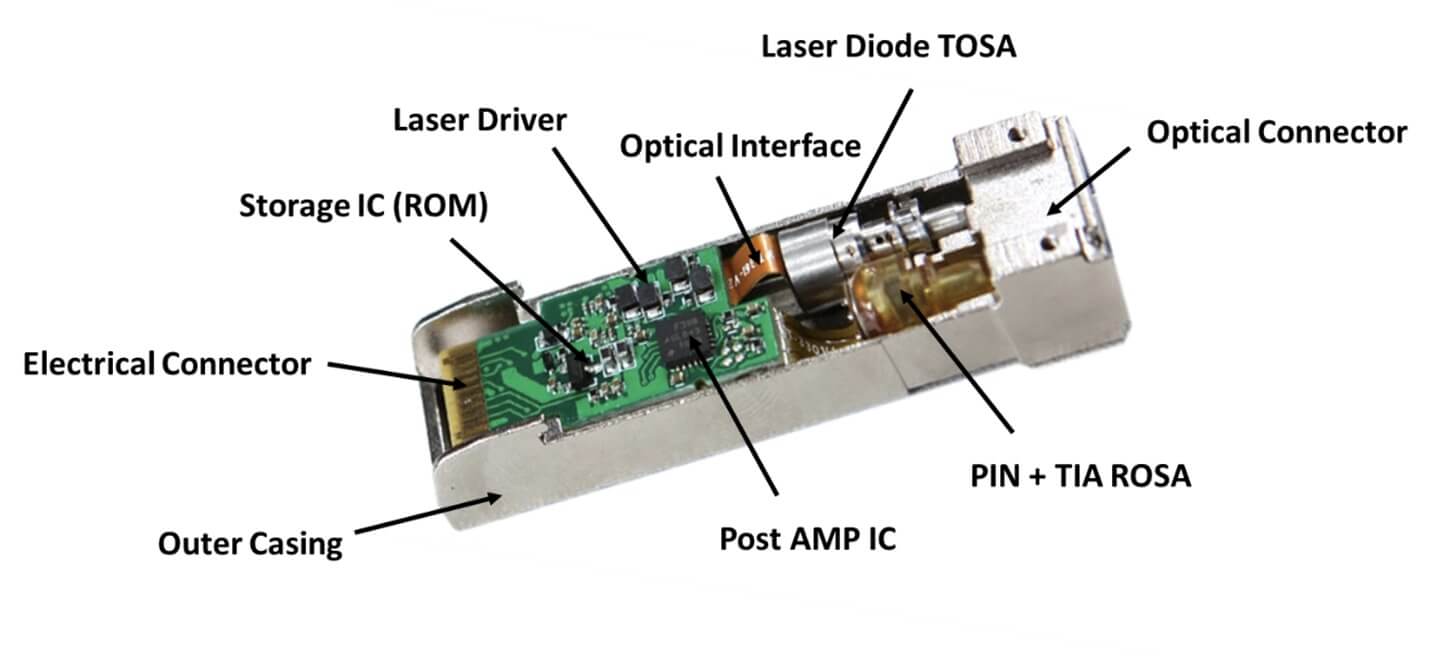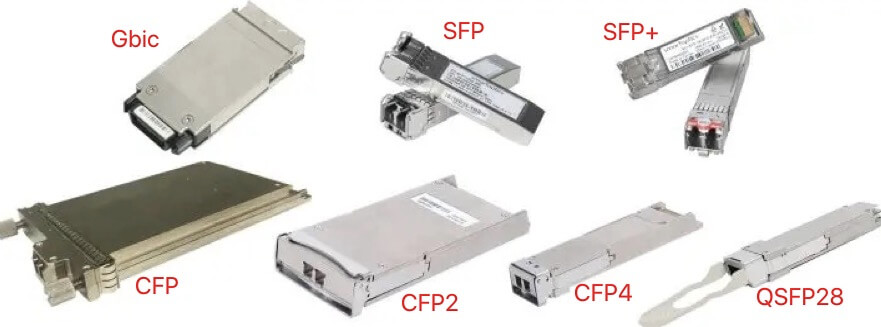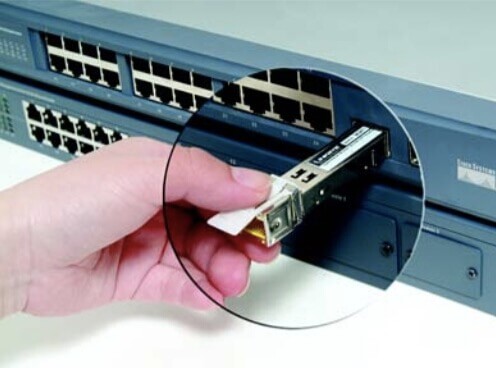Optical transceivers play a pivotal role across various industries in the tech realm. These components find extensive use in networking hardware setups. What makes optical transceivers indispensable in numerous industries is their ability to enable a single switch to accommodate diverse wiring and transmission formats for companies. In this article, we’ll delve into the fundamental understanding of optical transceivers, exploring their composition, and delving into the various types available in the market.
What is Fiber Optic Transceiver?
Fiber Optic Transceivers, also known as Optical Transceivers or Optical Modules, are compact devices that harness the power of fiber optic technology to transmit and receive data.
The term ‘Transceiver’ itself is a fusion of “Transmitter” and “Receiver.” Essentially, an optical transceiver houses both an optical transmitter and an optical receiver, sharing common circuitry or residing in a single housing.

Vital to optical network setups, these transceivers incorporate electronic components that condition and encode/decode data into light pulses, transmitting them as electrical signals to the other end. To convert data into light, they rely on light sources like VSCEL, FP, or DFB lasers. These light sources are under the control of electronic components. For receiving light pulses, photodiode semiconductors such as Pin or APD are employed.
Structure of A Fiber Optic Transceiver
The main components of an optical transceiver include an electrical input interface, an array of laser drivers, an array of light emitters, an optical multiplexer, an optical output connector, an optical input connector, an optical de-multiplexer, an array of light detectors, an array of trans-impedance amplifiers (TIA) and an electrical output interface.

Key Parameters of Optical Transceivers
- Data Rate: The rate of bits transmitted per second.
- Transmission Distance: Maximum distance for optical signal transmission. Choose modules and fibers based on this distance.
- Central Wavelength: Used waveband for signal transmission (e.g., 850 nm, 1310 nm, 1550 nm).
- Optical Transmit Power: Output power when an optic transceiver functions properly.
- Receiving Sensitivity: Minimum power at which the receiver can detect signals within a certain bit error rate.
- Fiber Mode: Defines fiber type based on core diameter. Single-mode for long distances, multi-mode for shorter.
- Connector Type: Interface to accommodate fiber (e.g., LC, SC, ST, FC, MPO).
- Extinction Ratio: Ratio of optical power with and without signals for modulation quality.
- Eye Diagram: Visual representation of received digital signal’s quality and modulation.
Types of Fiber Optic Transceivers
Optical transceivers come in a range of types, each tailored to specific methods and purposes, catering to a multitude of requirements.
By Transmission Rate
The transmission rate, which quantifies the bits transmitted per second, is typically measured in Mbps (Megabits per second) or Gbps (Gigabits per second). Optical transceivers can be classified into different types based on their transmission rates.
In the modern landscape, data transmission occurs at various rates, with some of the most prevalent speeds including:
- 155Mbps
- 1Gbps
- 2Gbps
- 4Gbps
- 8Gbps
- 10Gbps
- 16Gbps
- 25Gbps
- 40Gbps
- 100Gbps
- 200Gbps
- 400Gbps
Many of these speeds are streamlined into compact multi-lambda signals for enhanced efficiency. This is particularly notable in technologies like 5G wireless, which leverages 100G, 200G, and 400G signals.
When making a choice, it’s tempting to prioritize higher data rates, but the key lies in striking a balance between network performance, cost considerations, and budget constraints.
By Transceiver Form Factors
A variety of form factors are widely used for optical transceivers, each catering to specific data rates and needs:
- Small form-factor pluggable (1G SFP, 10G SFP+)
- Small form-factor pluggable 28 (25G SFP28)
- Quad small form-factor pluggable (40G QSFP+)
- Quad small form-factor pluggable 28 (100G QSFP28)
- 10 gigabit small form factor pluggable (XFP)
- Quad small form-factor pluggable double density (QSFP-DD or QSFP56-DD)
- Quad small form-factor pluggable 28 dual density (200G QSFP28-DD)
- Quad small form-factor pluggable 56 dual density (400G QSFP56-DD or QSFP-DD)
- C (100G) form factor pluggable (100G CFP)
- C form factor pluggable, half size (100G CFP2)
- C form factor pluggable, quarter size (100G CFP4)

Ensuring seamless compatibility between transceivers and other optical hardware is an essential prerequisite for achieving successful connections.
By Fiber Mode Type
Optical fibers come in two main types: single mode fiber (SMF) and multi-mode fiber (MMF). This division extends to optical transceivers, which are categorized as single mode and multi-mode transceivers, catering to the diverse demands of these fiber types.
- Single Mode Transceivers: Designed for long-range transmission, single mode transceivers cover distances of 10km to 160km. Operating at center wavelengths like 1310nm, 1490nm, or 1550nm, they’re optimized for single mode fibers. This makes them ideal for extensive or high-capacity transmission needs.
- Multi-Mode Transceivers: For shorter distances of 0.5km to 2km, multi-mode transceivers step in. They work on a center wavelength around 850nm, tailored for multi-mode fibers. Primarily used for cost-effective short-distance transmission, they suit scenarios where swift connectivity over smaller spans is the priority.
By Transmission Distance
When utilizing standard transceivers, there are four distinct types, each equipped with its own unique transmission distance capabilities:
- LR (Long Range) – Operates at 1310nm.
- SR (Short Range) – Operates at 850nm.
- ER (Extended Range) – Operates at 1550nm.
- ZR (Further Extended Range) – Operates at 1550nm.
Short reach optics are commonly deployed in environments like data centers, server farms, core networks, or single-site facilities. They’re favored for their cost-effectiveness, aiding in the reduction of capital and operational expenses.
On the other hand, long reach optics are reserved for scenarios demanding transmission of tightly packed WDM signals across larger distances, such as from campus to campus or core to edge connections.
By Wavelength
In the realm of optical transceivers for data transmission, infrared light takes the spotlight. Wavelength, which measures the distance between successive crests in a light wave, is a critical factor. Optical transceiver modules predominantly function at three primary wavelengths: 850nm, 1310nm, and 1550nm.
Multimode optical transceivers are optimized for operation at 850nm and 1300nm wavelengths, while singlemode optical transceivers are finely tuned for 1310nm and 1550nm wavelengths. Within the singlemode spectrum, precision transmitters allow for nuanced wavelength variations within both the 1310nm and 1550nm “windows.” This advanced capability is harnessed through standardized techniques such as Coarse Wavelength Division Multiplexing (CWDM) and Dense Wavelength Division Multiplexing (DWDM), enhancing data transmission possibilities.
By Transceiver Applications
Transceivers come in various forms to suit a multitude of applications. They are categorized based on their specific use cases, spanning a range of applications including:
- SONET/SDH (Synchronous Optical Networking / Synchronous Digital Hierarchy)
- FE/GE/10GE/40GE/100GE Ethernet (Fast Ethernet / Gigabit Ethernet / 10 Gigabit Ethernet / 40 Gigabit Ethernet / 100 Gigabit Ethernet)
- Broadcast Video
- CPRI (Common Public Radio Interface)
- LTE (Long-Term Evolution)
- Fibre Channel
This diversity ensures that transceivers are tailored to meet the distinct requirements of these various applications.
By Connector Type
In the world of transceivers, optical fiber connectors play a crucial role in facilitating light passage through the core. Transceiver modules can be organized into distinct categories according to their connector types. Presently, four primary types of fiber optic module connectors are commonly employed alongside optical transceivers: SC, LC, MPO, and ST.
Fiber Optic Transceiver Applications
Fiber Optic Transceivers are extensively used in wired networking applications like Ethernet, Fibre Channel, SONET/SDH/ONT, CPRI, FTTx, and InfiniBand. They are integrated into various devices like Ethernet switches, routers, firewalls, network interface cards, and fiber media converters.
Furthermore, storage interface cards, known as HBAs or Fibre Channel storage switches, utilize these fiber optic transceivers for diverse speeds including 2Gb, 4Gb, 8Gb, and 16Gb.
Development Trend of Fiber Optic Transceivers
Optical modules are moving towards higher speeds like 400G, 800G, and 1.6T. This demand for speed comes with needs for low power, small size, and cost efficiency. Traditional optical tech faces limits as speeds increase, creating a bottleneck. However, silicon photonics integration is changing this. It’s highly integrated and energy-efficient, breaking through barriers. Many manufacturers invest in silicon photonics modules. High-speed optical modules with this tech are already in use in data centers.
Conclusion
Understanding optical transceivers can be challenging if you’re not tech-savvy. If you’re unsure which optical transceiver suits your network, reach out to Bonelinks. We specialize in optical transceivers and can guide you effectively.




